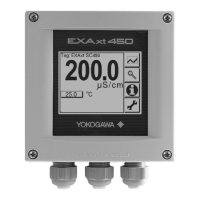IM 12D08N05-01E
5-8
<5. MENU STRUCTURE COMMISSIONING>
l
Integral control
Integral control is used to eliminate the steady state error and any future process changes.
Itwillaccumulatesetpointandprocess(load)changesbycontinuingtoadjusttheoutput
untiltheerroriseliminated.Smallvaluesofintegralterm(I-timeinseconds)providequick
compensation, but increase overshoot. Usually, the integral term is set to a maximum
valuethatprovidesacompromisebetweenthethreesystemcharacteristicsof:overshoot,
settlingtime,andthetimenecessarytocanceltheeffectsofstaticloading(process
changes).Theintegraltermisprovidedwithanantiwindupfunction.WhentheoutputofPI
portionofthecontrollerisoutsidethecontrolrange(lessthan-5%orgreaterthan105%),
the I-part is frozen.
l
Derivative control
Thecontrolactsontheslope(rateofchange)oftheprocessvalue,therebyminimizing
overshoot. It provides “rate” feedback, resulting in more damping. High derivative gains
can increase the rising time and settling time. It is difficult to realize in practice because
differentiation leads to “noisy” signals.
SP
PV
e
+
-
+
+
+
+
+
-
e
Range
∫e dt
1
T
i
T
d
dPV
dt
z
Process
Controller
Actuator
Process
Figure 5.1 Control Diagram
l
Expiretime
Iftheoutputisover100%forlongerthantheexpiretime,theoutputwillreturnto0%.
l
Damping time
The response to a step input change reaches approximately 90 percent of its final value
within the damping time.
100%
0%
set
point
process
value
Direct
100%
0%
set
point
process
value
Reverse
range
range
manual
reset
manual
reset
Figure 5.2 Direct/Reverse action

